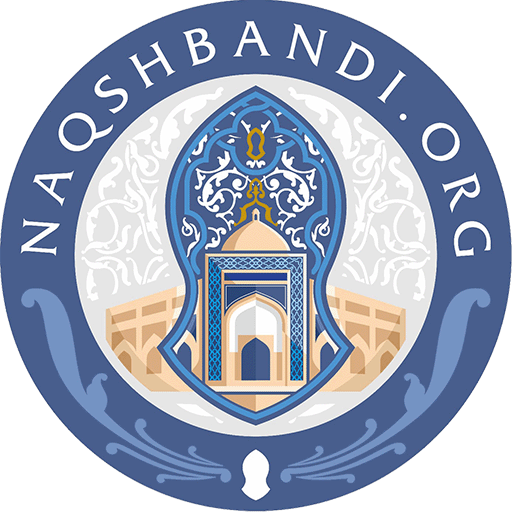الورثة
The First Spiritual Inheritors of the Prophet
Historically speaking, the Naqshbandi tariqat can be traced back to the first of the Rightly-Guided Caliphs, Abu Bakr as-Siddiq (r), who succeeds the Prophet (s) in his knowledge and in his role of guiding the Muslim community. Allah said in the Holy Qur’an “He was the second of two in the cave, and he said to his friend: ’do not be sad, for God is with us’” [9:40]. Of him the Prophet (s) said, “If I had taken to myself a beloved friend, I would have taken Abu Bakr as my beloved friend; but he is my brother and my companion.”
What distinguishes the Naqshbandi school from other Sufi orders was the fact that it took its foundations and principles from the teachings and example of six bright stars in the firmament of the Prophet (s). These great figures were: Abu Bakr as-Siddiq, Salman al-Farisi, Jaجfar as-Sadiq, Bayazid Tayfur al-Bistami, جAbdul Khaliq al-Ghujdawani, and Muhammad Baha’uddin Uwaysi al-Bukhari, known as Shah Naqshband–the eponymous Imam of the tariqat.
Behind the word “Naqshband” stand two ideas: نقش which means “engraving” and suggests engraving the name of Allah in the heart, and bandwhich means “bond” and indicates the link between the individual and his Creator. This means that the Naqshbandi follower has to practice his prayers and obligations according to the Holy Qur’an and the Sunnah of the Prophet (s) and to keep the presence and love of Allah alive in his heart through a personal experience of the link between himself and his Lord.
Besides Abu Bakr as-Siddiq, who are these stars in the firmament of the Prophet (s)? One of them was Salman al-Farisi (r). His origin was Isfahan in Persia and he was the one who advised the Muslims to dig a trench in the battle of Ahzab. After the Muslims seized al-Mada’in, the capital city of Persia, he was made Prince and governor of that city and remained there until his death.
Another star was Jaجfar as-Sadiq. A descendant of the Prophet (s) on his father’s side and of Abu Bakr (r) on his mother’s, he rejected all positions of honor in favor of retreat and spiritual learning and practice. He was called “The Inheritor of the Prophetic Station (مقام النبوة) ووارث المقام الصادق (Maqam as-Siddiqiyya).
The oldest recorded occurrence of the term safa was in reference to his student, Jabir ibn Hayyan, in the middle of the second Hijri century. He was a مُفَسِّرُ الْقُرْآنِ or master in exegesis, a scholar of hadith, and one of the greatest المجتهدون (qualified to give legal decisions) in Madinah. His Tafsir is partially preserved in Sulami’s haqa’iq at-tafsir. Layth ibn Saجd, one of the most reliable transmitters of prophetic traditions, witnessed Jaجfar’s miraculous powers as the latter was able to ask for anything, and God would grant it to him on the spot.
Another star was Bayazid Tayfur al-Bistami whose grandfather was a Zoroastrian. Bayazid made a detailed study of the statutes of Islamic law(shariجa) and practiced a strict regimen of self-denial. All his life he was assiduous in the practice of his religious obligations. He urged his students (مريدs) to put their efforts in the hands of God and he encouraged them to accept a sincere and pure doctrine of tawhid, knowledge of the Oneness of God. This doctrine, he said, imposes five obligations on the sincere:
- To keep obligations according to the Qur’an and Sunnah;
- To always speak the truth.
- To keep the heart free from hatred.
- To avoid forbidden food (haram).
- To shun innovation (bid`a).
Bayazid said that the ultimate goal of the Sufis is to know God in this world, to reach His Divine Presence, and to see Him in the Hereafter. To that effect he added: “There are special servants of Allah who, if Allah veiled them from His vision in Paradise, would have implored Him to bring them out of Paradise as the inhabitants of the Fire implore Him to escape from Hell.”
Yet another star in the firmament of the Prophet (s), was جAbdul Khaliq al-Ghujdawani, who was born in the village of Ghujdawan, near Bukhara in present-day Uzbekistan. He was raised and buried there. He studied Qur’an and the Islamic sciences of both external and internal knowledge until he reached a high station of purity. He then traveled to Damascus where he established a school from which many students graduated and went on to become masters of الفقه و hadith as well as spirituality in their time, both in the regions of Central Asia and in the Middle East.
جAbdul Khaliq continued the work of his predecessors by formulating the ذِكْر (remembrance of God) passed down from the Prophet (s) according to the Sunnah. In his letters he set down the code of conduct (adab) that the students of the Naqshbandiyya were expected to follow.
